Even though the term gets thrown around willy-nilly on this here internet, allow me to state that the current Bundesliga truly is… wild. Like, wild-wild. After seven matchdays, the glorious amount of two (!) total points separates the league leaders from seventh place - and that doesn’t even take into consideration that the team in eighth place is supposed title contender Borussia Dortmund, who’ve had a slow start under Lucien Favre this year. Fittingly, the surprise-filled start to this Bundesliga campaign has produced a surprise outfit at the very top of the standings: Borussia Mönchengladbach. After a disappointing 2018-19, where they squandered Champions League qualification after seemingly having sat comfortably in a top four spot for most of the season, but being leapfrogged by Bayer Leverkusen in the final weeks - after taking only nine total points from their last 12 games of the campaign - Die Fohlen (The Foals) were expected to have somewhat of a down year. Star player Thorgan Hazard moves to Dortmund and big-time prospect Mickaël Cuissance jumped to Bayern Munich, while captain Lars Stindl and midfield mainstay Jonas Hofmann has long term injury absences in the opening months. But newly appointed manager Marco Rose, who’s come over from Red Bull Salzburg - and has taken assistant René Maric, he of Spielverlagerung fame, with him - has transformed his new team in rapid fashion. Of course, Gladbach is enjoying the benefits of some overperformances in certain areas (we’ll get to that), but this side really seems to be a legit top four candidate. Let’s take a look at the surprise team of this young Bundesliga season, by looking at the team per positional group, starting with the attack.
Attack
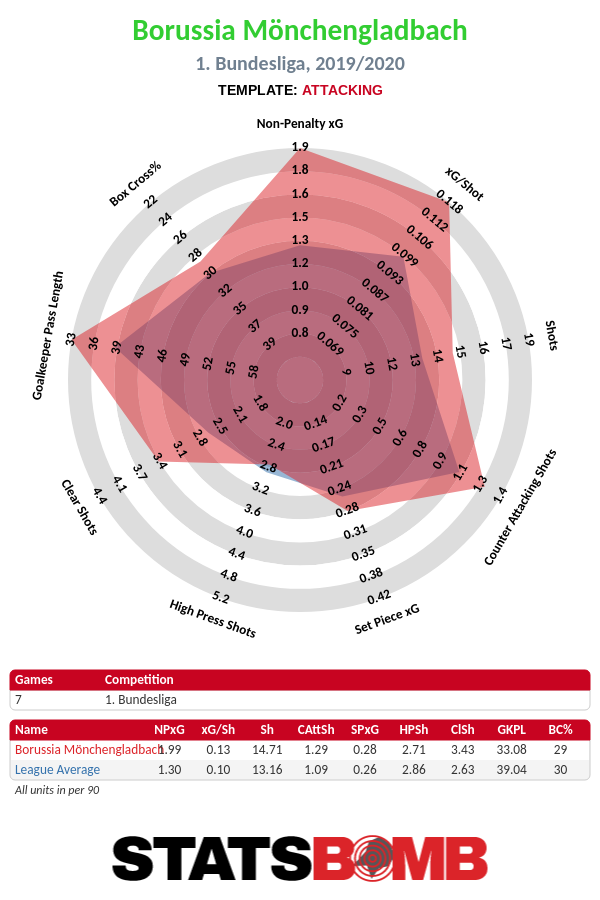 As you can see in the plot above, Mönchengladbach have all the makings of a genuinely good offensive team. The difference in attacking output with last year, where they were almost the definition of a league-average team, is quite staggering.
As you can see in the plot above, Mönchengladbach have all the makings of a genuinely good offensive team. The difference in attacking output with last year, where they were almost the definition of a league-average team, is quite staggering. 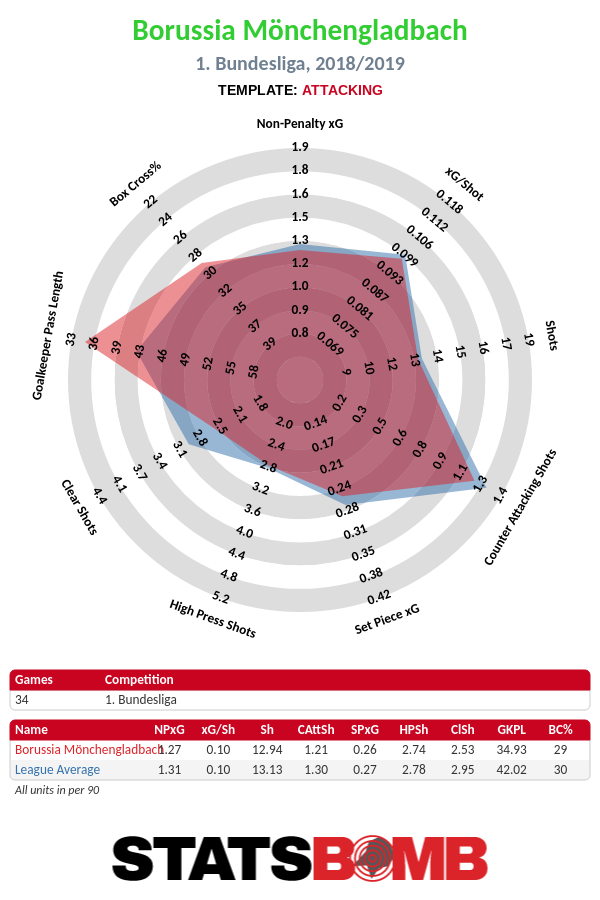 With four goals and four assists in the first seven matchdays, Alassane Pléa is the first player that jumps out, if you’ve only seen glimpses of Gladbach this year. The French attacker, who turned 26 years old in March, should earn some national team consideration from manager Didier Deschamps. But yeah… no need to dreg open the Sébastien Haller-and-other-strikers-who-are-not-Olivier-Giroud-wormhole again here. With 24 goals and assists combined in his first 41 league games for Mönchengladbach, Pléa is starting to justify the relatively hefty price tag that Die Fohlen had to pay OGC Nice in the summer of 2018 (23 million Euros).
With four goals and four assists in the first seven matchdays, Alassane Pléa is the first player that jumps out, if you’ve only seen glimpses of Gladbach this year. The French attacker, who turned 26 years old in March, should earn some national team consideration from manager Didier Deschamps. But yeah… no need to dreg open the Sébastien Haller-and-other-strikers-who-are-not-Olivier-Giroud-wormhole again here. With 24 goals and assists combined in his first 41 league games for Mönchengladbach, Pléa is starting to justify the relatively hefty price tag that Die Fohlen had to pay OGC Nice in the summer of 2018 (23 million Euros). 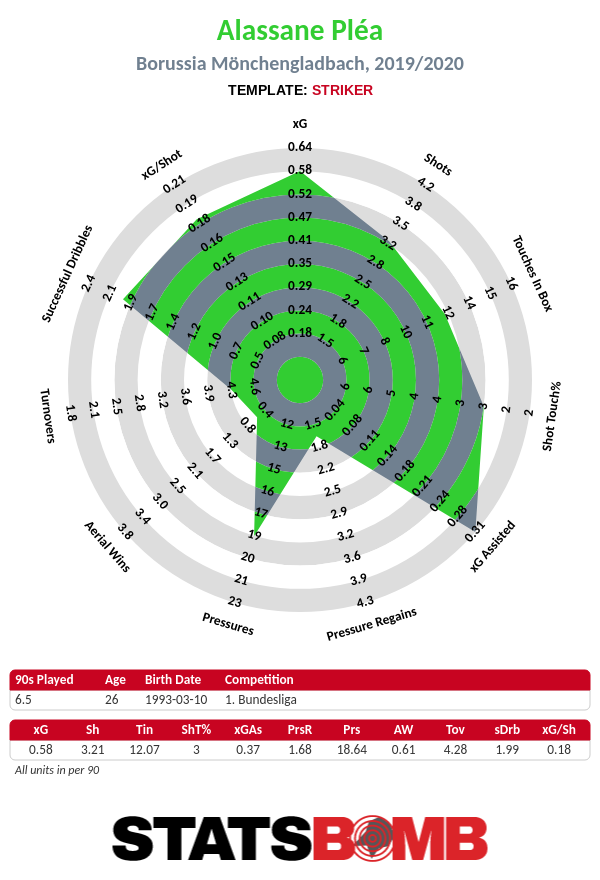 Mönchengladbach also bought Pléa’s striking partner in France. But, in contrast to the Pléa fee, the 9 million Euros that relegated EA Guingamp asked for Marcus Thuram, son of Lillian, seemed to be an absurdly low amount for such a solid young attacking talent. Thuram (22) is one of the rare cases of an offensive player that combines above average speed, strength, shooting skills and ball control, but was inconsistent enough in his first few years in the tough Ligue 1 to come at an affordable rate for Mönchengladbach.
Mönchengladbach also bought Pléa’s striking partner in France. But, in contrast to the Pléa fee, the 9 million Euros that relegated EA Guingamp asked for Marcus Thuram, son of Lillian, seemed to be an absurdly low amount for such a solid young attacking talent. Thuram (22) is one of the rare cases of an offensive player that combines above average speed, strength, shooting skills and ball control, but was inconsistent enough in his first few years in the tough Ligue 1 to come at an affordable rate for Mönchengladbach. 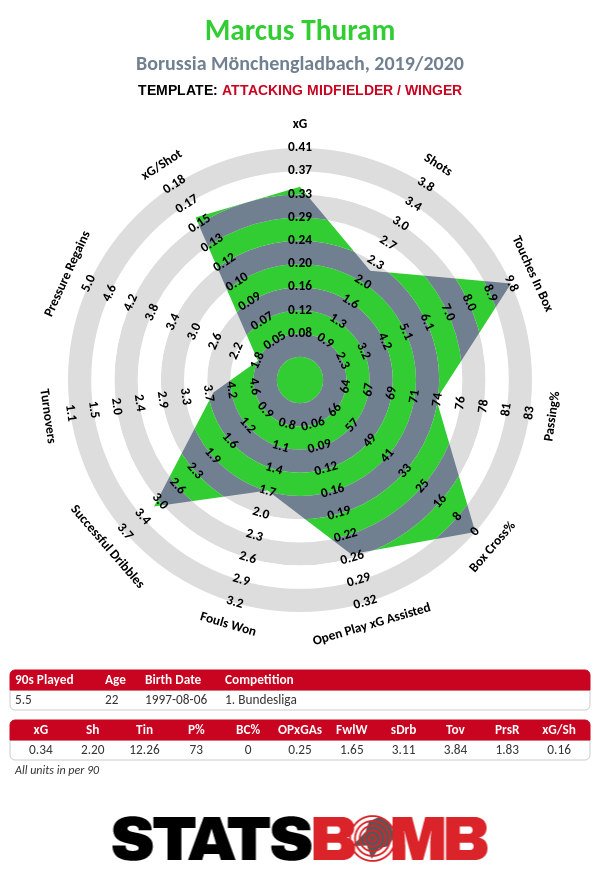 Like Pléa, Thuram is speedy enough to either play as aN out-and-out central striker or as an inverted winger, which really helps in Gladbach’s new system. In possession, Rose’s squad lines up in an unconventional version of a 4-4-2 diamond shape - whilst in defense, they press and drop back in the frames of a 4-2-3-1 shape - with both strikers alternately occupying (semi-)winger positions, especially when they break.
Like Pléa, Thuram is speedy enough to either play as aN out-and-out central striker or as an inverted winger, which really helps in Gladbach’s new system. In possession, Rose’s squad lines up in an unconventional version of a 4-4-2 diamond shape - whilst in defense, they press and drop back in the frames of a 4-2-3-1 shape - with both strikers alternately occupying (semi-)winger positions, especially when they break. 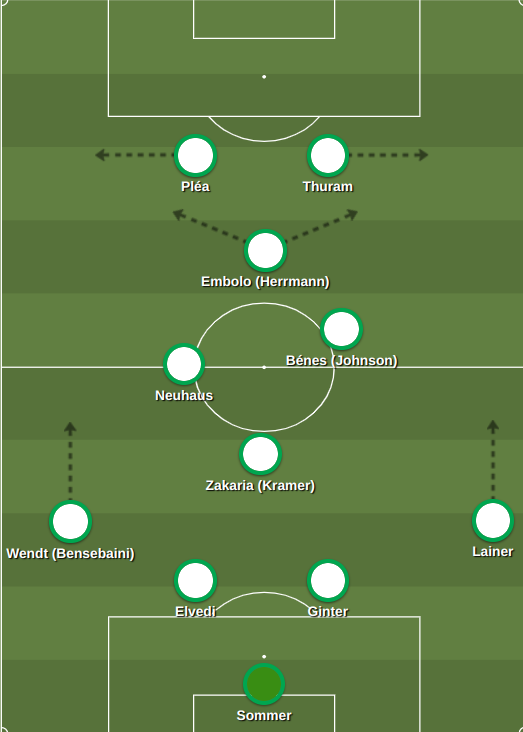 And whoo boy, Mönchengladbach can certainly play some fast-break ball at breakneck speed. Of the fifteen goals Die Fohlen have scored this season, only three were preceded by an attack consisting of more than five passes in the build-up to the final shot. Rose’s squad plays extremely vertical, even though they rarely hoof a desperate long ball up the pitch. The fact that Rose & co. have managed to significantly up Gladbach’s high-press of the opponent’s buildup in such a short time is quite impressive. But the improvement of razor sharp attacking patterns in their transition from defense to offense has been truly remarkable. The individual performances and skill-sets from the three players up top - Pléa and Thuram assisted by either Breel Embolo (attempting a comeback from a horrible form spell at Schalke) or Patrick Herrmann - have really helped this quick turnaround. Put it all together and you have a team averaging 0.13 expected goals per shot, the second highest total in the league. Combine that with the third highest shot total in it leaves Gladbach as the most potent attacking Bundesliga team to date with 1.99 non-penalty xG per match this season.
And whoo boy, Mönchengladbach can certainly play some fast-break ball at breakneck speed. Of the fifteen goals Die Fohlen have scored this season, only three were preceded by an attack consisting of more than five passes in the build-up to the final shot. Rose’s squad plays extremely vertical, even though they rarely hoof a desperate long ball up the pitch. The fact that Rose & co. have managed to significantly up Gladbach’s high-press of the opponent’s buildup in such a short time is quite impressive. But the improvement of razor sharp attacking patterns in their transition from defense to offense has been truly remarkable. The individual performances and skill-sets from the three players up top - Pléa and Thuram assisted by either Breel Embolo (attempting a comeback from a horrible form spell at Schalke) or Patrick Herrmann - have really helped this quick turnaround. Put it all together and you have a team averaging 0.13 expected goals per shot, the second highest total in the league. Combine that with the third highest shot total in it leaves Gladbach as the most potent attacking Bundesliga team to date with 1.99 non-penalty xG per match this season.
Midfield
Former manager Dieter Hecking opted for a 4-3-3 formation last season, with a frontline of dribbling master Hazard on the left, captain Stindl as a useful, team-oriented Falscher Neun (‘false nine’), and Pléa as a striker-on-the-wing as the team’s main calling card. Hecking’s player preferences were a lot less interesting: his favorite midfield seem to consist of the talented Florian Neuhaus and bankable Hofmann in the more attacking roles, with the unspectacular Tobias Strobl as the defensive counter-balance behind them. Swiss midfield talent Denis Zakaria only played in about half the available minutes, last season. A larger role for Zakaria is one of the major changes in midfield this season. The former BSC Young Boys dynamo is a true physical presence in this area, but is also a tactically smart cog in Gladbach’s up-tempo build-up from the back. 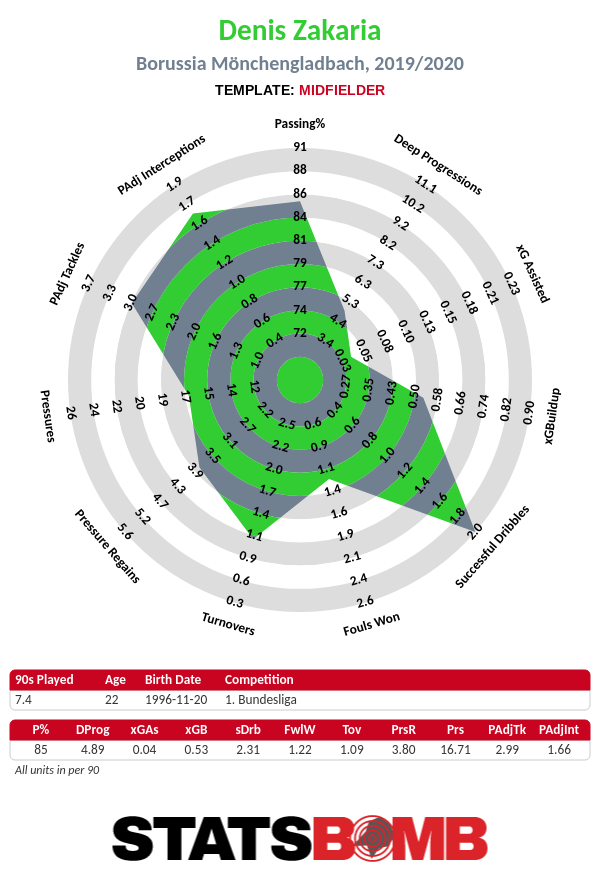 In the two box-to-box slots of the diamond, Rose had handed the keys to the two creatively talented youngsters of the squad, Neuhaus and the 22 year-old Slovakian László Bénes. The stylish allrounder Neuhaus (also 22) seems to be the prime candidate as a future record-sell for Mönchengladbach. He has the ball control, vision and positional smarts to excel in a multitude of midfield roles, and combines these skills with some very deft dribbling.
In the two box-to-box slots of the diamond, Rose had handed the keys to the two creatively talented youngsters of the squad, Neuhaus and the 22 year-old Slovakian László Bénes. The stylish allrounder Neuhaus (also 22) seems to be the prime candidate as a future record-sell for Mönchengladbach. He has the ball control, vision and positional smarts to excel in a multitude of midfield roles, and combines these skills with some very deft dribbling.
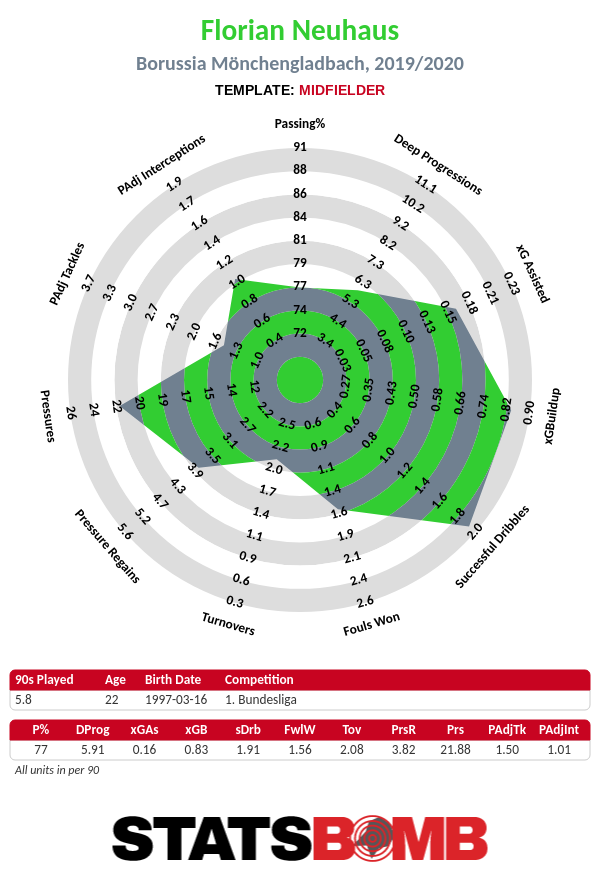 Defense
Defense
At right-back, Stefan Lainer, who joined Rose and Maric in their switch to the Ruhrgebiet city, is enjoying a very pleasant first couple of months in the German Bundesliga, after years of being a solid contributor in the Austrian one. But Gladbach’s backline gets defined by their central pairing, German international Matthias Ginter (25) and Swiss international Nico Elvedi (23), who have already tallied up a combined total of 328 top-flight Bundesliga games, despite their age. 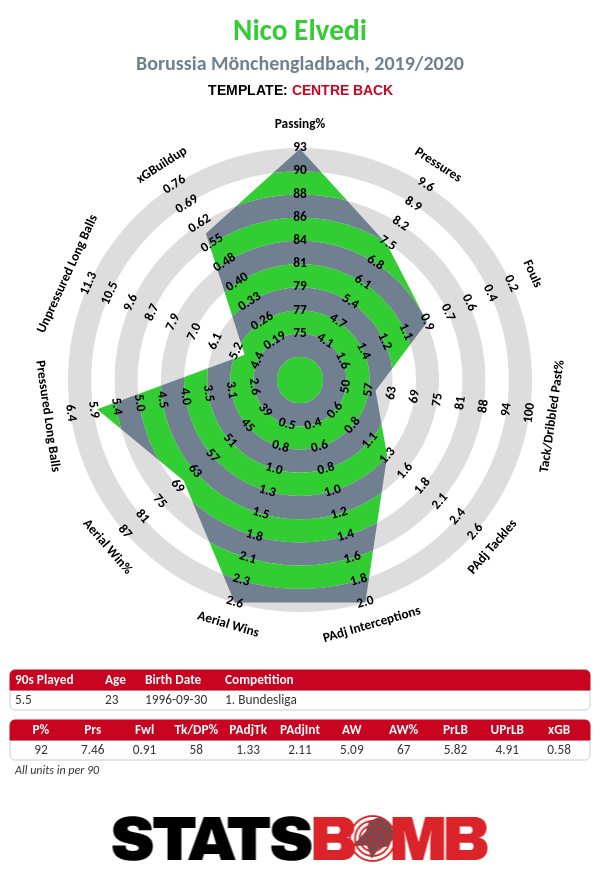
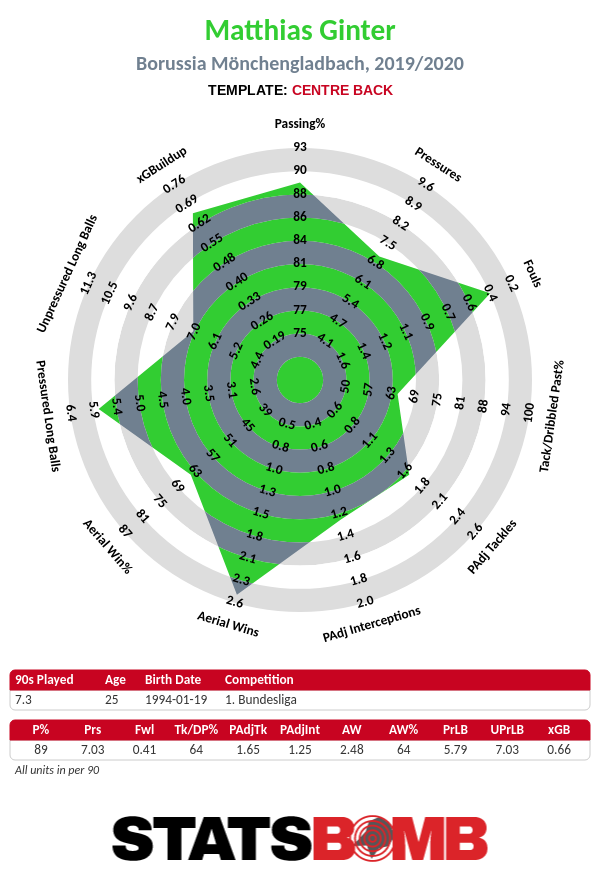 Neither Ginter nor Elvedi possess elite speed for central defenders for a top club in an elite competition, but they are both very good passers of the ball. Their swift and accurate ball movement in the early stages of Mönchengladbach’s possessions is a necessity with the current playing style.
Neither Ginter nor Elvedi possess elite speed for central defenders for a top club in an elite competition, but they are both very good passers of the ball. Their swift and accurate ball movement in the early stages of Mönchengladbach’s possessions is a necessity with the current playing style.
Goalkeeper
But, I promised you some Debbie Downer-y talk of overperformance, so here we go. While the offensive numbers of Mönchengladbach have been downright impressive, such is not the case on the defensive end. Their high-octane press has been very effective, and has thrown many of their opponents visibly off their game, while also serving as a springboard for their quick, decisive counter-attacks. But their current total of 6 goals conceded is thanks in large part to opposing offenses underperforming with regards to their finishing, and, even more importantly, to a spell of absolutely ridiculous super-form of goalie Yann Sommer. 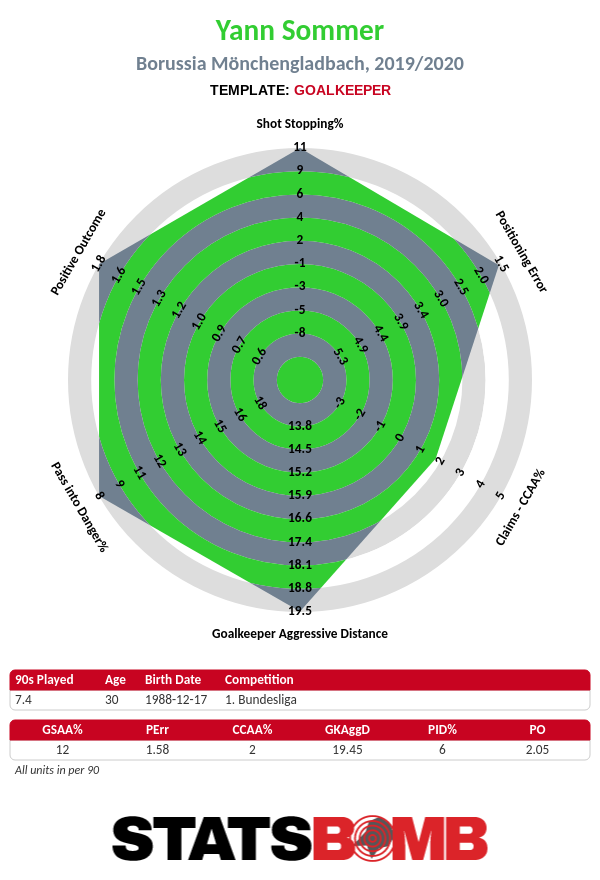
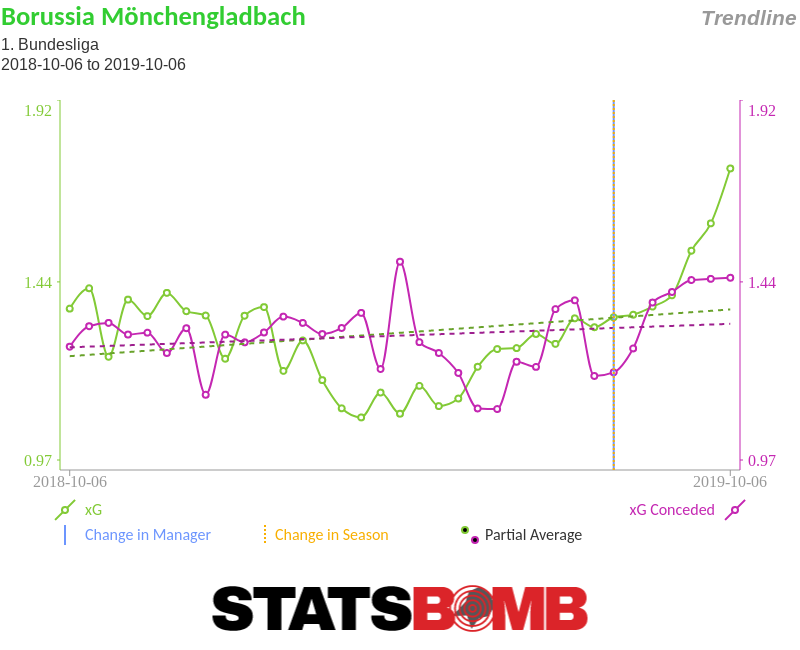 The Swiss goalkeeper‘s performance this season should be mentioned in debates about the best in the world. He’s saved 11.8% more goals than an average keeper would be expected to save given the set of shots he’s faced, that’s the second biggest gap in the league. He might just singlehandedly will Gladbach on a hot streak in his current form. But, defensively, this team is mortal, that’s for sure. Lucky for them that they are downright sexy, when it comes to attack.
The Swiss goalkeeper‘s performance this season should be mentioned in debates about the best in the world. He’s saved 11.8% more goals than an average keeper would be expected to save given the set of shots he’s faced, that’s the second biggest gap in the league. He might just singlehandedly will Gladbach on a hot streak in his current form. But, defensively, this team is mortal, that’s for sure. Lucky for them that they are downright sexy, when it comes to attack.